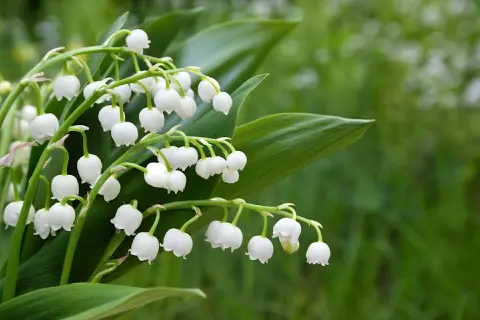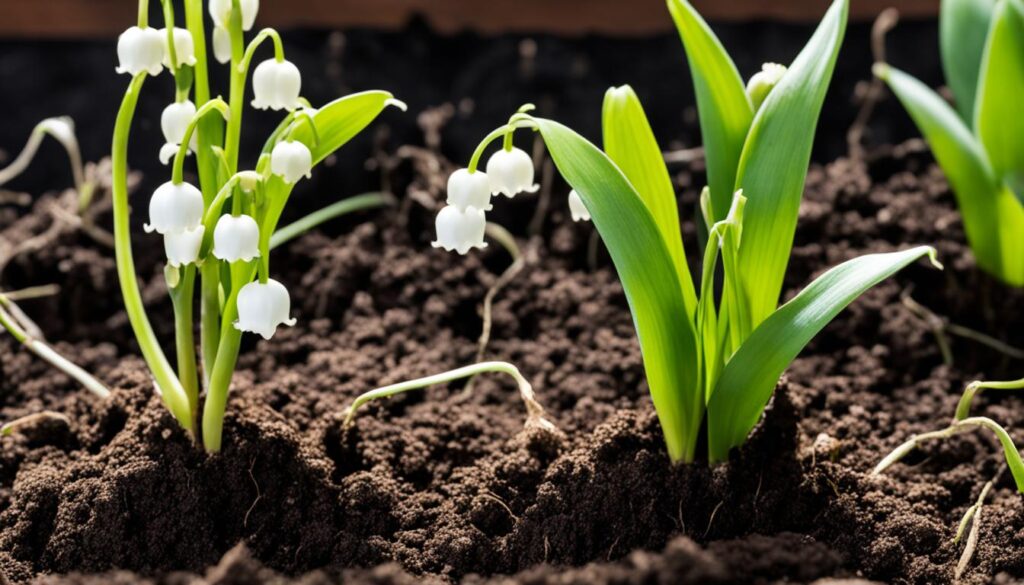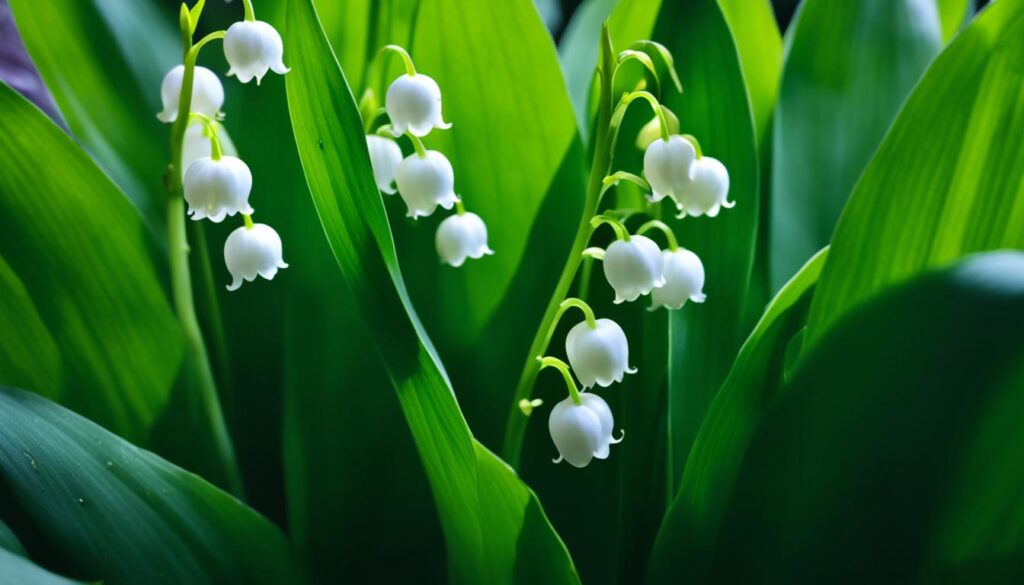
Have you ever been captivated by the delicate, bell-shaped blooms and enchanting fragrance of the Lily of the Valley?
This shade-loving perennial is a true harbinger of spring. It covers woodland floors and garden beds with its lush green foliage and delicate flowers. But what makes this plant so special, and how can you incorporate it into your own landscape? In this comprehensive guide, we'll uncover the secrets of the Convallaria majalis, the beloved Lily Valley.
What is Lily of the Valley?
Lily of the Valley is a lovely, aromatic flower that many adore. It is a small, herbaceous plant with beautiful, white flowers. These flowers have a captivating scent. It's a great choice for any garden thanks to its low, spreading nature.

Quick facts
- Common name(s): Lily-of-the-valley, May bells, Our Lady's tears, Mary's tears
- Scientific name: Convallaria majalis
- Family: Lilies
- Origin: native
- Flowering season: May to June
- Habitat: woodland
Description and Characteristics of Lily valley
This plant grows about 6 to 12 inches high and wide. It has slender green stems and white, bell-shaped flowers. Each flower has six white petals fused into a bell.
The leaves are lance-shaped and provide a green background. They are 4 to 8 inches long and 3 to 5 inches wide. They make the plant look even more beautiful.
Lily of the Valley's scent is sweet and musky, a favorite for perfumes. It's also a top pick for wedding flowers. The plant has a dense root system. This lets it spread out and cover the ground like a carpet.
Botanical Name and Origins of Lily-of-the-valley
The botanical name is Convallaria majalis. This means “the lily of the valley” in Latin. It comes from Europe and Asia's shaded, damp woodlands. Besides its formal name, it's also called muguet, May lily, and May bells.
While not threatened, lily of the valley is very poisonous. It contains over 30 heart-poisoning compounds. So, use caution, especially with kids and pets around.
Growing Lily of the Valley
Lily of the Valley is a known evergreen. It loves a few locations to grow. Places with light to moderate shade are ideal. But, it can also live in full shade or full sun, depending on the soil's water content. It needs well-drained soil that stays moist. The best time to plant it is in fall. This gives the roots time to grow strong before winter.
Where to Plant
Lily of the Valley thrives in light or moderate shade. It will also be okay in full sun but not if it's too dry. The soil must be well-drained and moist, with a pH level between 5.0 and 7.0. If your ground keeps water too long, add compost or manure. This will improve the drainage and give the plants the nutrients they need.
When to Plant
The best time to plant lily of the valley is in the fall. Try to plant between September and November. This way, the plant's roots get strong before winter. A good beginning in the spring means healthier plants.
How to Plant Lily valley
When planting lily of the valley, cover the roots lightly. Leave the tops a little above the ground. Place them about 4 inches apart. They will grow and fill the space. If using a pot, the same rules apply.
Adding compost or manure to the soil helps your plants. Mix it in before planting. This will help the plants grow better and have more flowers.
Lily of the Valley Care and Maintenance
Making sure your lily of the valley plants are healthy and vibrant means looking after their specific water and light needs. If you give them the proper care, these sweet-smelling flowers will grow well. They will bring joy to your garden for years.
Water and Light Requirements
Lily of the valley plants prefer their soil to be damp. They need about 1 inch of water each week, from rain or your watering. These plants do well in shade but can also thrive in full sunlight if the soil stays moist.
Adding mulch around them helps keep the soil damp. It also keeps their roots cool in hot weather.
Over time, lily of the valley plants become low-maintenance. Their thick green leaves use sunlight to grow, so pruning is minimal. By caring for them right, these tough plants will keep growing and spreading. You'll see more of their beautiful spring flowers in your garden.
| Lily of the Valley Care Requirement | Details |
|---|---|
| Lily of the valley water requirements | Approximately 1 inch of water per week, either from rainfall or supplemental irrigation to keep the soil consistently moist. |
| Lily of the valley light requirements | The plants thrive in partial shade but can also tolerate full sun, as long as they receive adequate moisture. |
| Lily of the valley maintenance | Once established, lily of the valley requires very little maintenance, as the leaves gather sunlight to feed the plants without the need for deadheading or pruning. |
Remember, lilies of the valley love shady spots and cooler temperatures. So, pick a good place for them. With the right care and conditions, you'll enjoy a lot of blooms from your hard work.
Common Problems and Solutions
Pests and Diseases
Lily of the valley plants are easy to take care of. But sometimes, they can get pests and diseases. These can make the plant look bad and hurt it. It's good to know how to deal with these issues. This will help your lily of the valley stay healthy.
Pest Problems:
- Spider mites make webbing and can cause yellow or brown spots on leaves. You can get rid of them by cleaning the leaves with a wet cloth or using neem oil or soap for bugs.
- Scale insects look like brown or tan bumps and leave a sticky residue. You can kill them by using oil that's meant for plants or soap for bugs.
- Having too many fungus gnats or fruit flies could mean you are watering too much or the air is too damp. You can stop them by watering less and using traps that are yellow and sticky.
- Mealybugs look like white, cottony spots, mostly in the folds of leaves. You can get rid of them by hand with some alcohol on a cotton ball. Or, use neem oil to stop them before they start.
Disease Issues:
- Leaf spots from a fungus can happen when water hits the leaves from a sprinkler. To avoid this, make sure air can circulate around the plant well. Don't water from above.
- Seeing yellow spots on top of the leaves could be rust. Take out the bad leaves and let more air in to help the plant fight this disease.
- Fungal rot can kill your plant's roots or stems. Make sure the plant isn't sitting in water and don't water too much to avoid this. Good drainage is critical.
- Southern blight is a fungus that can really harm your lily of the valley plants. Check your plants a lot and if you find a sick one, remove it fast to stop the spread of this disease.
To keep your lily of the valley growing well, check on them often. If you see any pests or diseases, deal with them fast. Also, make sure the environment is good for the plant. A mix of cleaning, using the right tools, and some specific treatments can help. This way, your lily of the valley will make beautiful and fragrant flowers.

Keep in mind, lilies of the valley love shady spots and cooler temperatures. So, pick a good place for them. With the right care and conditions, you'll enjoy a lot of blooms from your hard work.
Common Problems and Solutions
Pests and Diseases
Lily of the valley plants are easy to take care of. But sometimes, they can get pests and diseases. These can make the plant look bad and hurt it. It's good to know how to deal with these issues. This will help your lily of the valley stay healthy.
Pest Problems:
- Spider mites make webbing and can cause yellow or brown spots on leaves. You can get rid of them by cleaning the leaves with a wet cloth or using neem oil or soap for bugs.
- Scale insects look like brown or tan bumps and leave a sticky residue. You can kill them by using oil that's meant for plants or soap for bugs.
- Having too many fungus gnats or fruit flies could mean you are watering too much or the air is too damp. You can stop them by watering less and using traps that are yellow and sticky.
- Mealybugs look like white, cottony spots, mostly in the folds of leaves. You can get rid of them by hand with some alcohol on a cotton ball. Or, use neem oil to stop them before they start.
Disease Issues:
- Leaf spots from a fungus can happen when water hits the leaves from a sprinkler. To avoid this, make sure air can circulate around the plant well. Don't water from above.
- Seeing yellow spots on top of the leaves could be rust. Take out the bad leaves and let more air in to help the plant fight this disease.
- Fungal rot can kill your plant's roots or stems. Make sure the plant isn't sitting in water and don't water too much to avoid this. Good drainage is critical.
- Southern blight is a fungus that can really harm your lily of the valley plants. Check your plants a lot and if you find a sick one, remove it fast to stop the spread of this disease.
To keep your lily of the valley growing well, check on them often. If you see any pests or diseases, deal with them fast. Also, make sure the environment is good for the plant. A mix of cleaning, using the right tools, and some specific treatments can help. This way, your lily of the valley will make beautiful and fragrant flowers.
| Pest/Disease | Description | Treatment |
|---|---|---|
| Spider Mites | Cause fine webbing and yellow or brown leaf spots | Wipe leaves with damp cloth, use neem oil or insecticidal soap |
| Scale Insects | Appear as brown or tan bumps on stems and leaves, with sticky residue | Apply horticultural oil or insecticidal soap |
| Fungus Gnats and Fruit Flies | Indicators of overwatering or high humidity | Reduce watering, use yellow sticky traps |
| Mealybugs | Create white, cottony masses in leaf crevices | Remove manually with alcohol, use neem oil |
| Leaf Spots | Form from overhead watering or standing water on leaves | Maintain air circulation, avoid overhead watering |
| Rust Fungus | Appears as yellow patches on the top of leaves | Remove affected leaves, improve air flow |
| Fungal Rot | Can cause plant collapse, including crown and stem rot | Ensure proper drainage, avoid overwatering |
| Southern Blight | Caused by Sclerotium rolfsii fungus, can be devastating | Monitor closely, promptly remove affected plants |
Is Lily of the Valley Poisonous?
Lily of the valley (Convallaria majalis) is very dangerous. It can harm kids and pets a lot. The whole plant has toxins that can hurt the heart, leading to serious problems if eaten.
The plant has dangerous compounds like convallatoxin and convallarin. These can mess with the sodium-potassium pump in our body's cells. This can cause problems like sickness, irregular heartbeats, and maybe even cardiac arrest.
Just eating one to five of its berries can be very dangerous. Symptoms usually start within a few hours. They can last from one to three days, depending on how much was eaten.
To avoid poisoning, be careful with lily of the valley and keep it away from kids and pets. If you think someone ate some, get help right away. Call the Poison Help hotline at 1-800-222-1222. They can give you advice.
Lily of the valley is pretty and smells nice, but it's also very harmful. Being careful and know the risks allows you to enjoy its beauty safely. Always put your family and pets' safety first.

Lily-of-the-valley
Lily of the Valley is a favorite plant in the spring. It's loved for its sweet smell and fast spread. This plant can cover the ground beautifully. Though it looks fragile, Lily of the Valley is very tough. It can grow in many places, from shade to full sun. This makes it perfect for spring gardens.
It grows up to 20cm and has won the Royal Horticultural Society's Award of Garden Merit. This means it's a top pick for gardens. Found across the northern hemisphere, it's the May birth flower. This plant is not just beautiful; it's also strong and can last for years.
Lily of the Valley loves shady, moist places. It blooms for 3 weeks in late spring. During this time, it shows off its white, bell-shaped flowers. It's not just pretty; it's also meaningful. It's mentioned in the Bible and was Queen Elizabeth II's favorite. It even became a symbol for Dior Couture.
But, it's crucial to remember that Lily of the Valley is very poisonous. Every part of it should not be eaten. This is key for people with kids or pets. They need to be careful if they plant it.
If you want something magical in your garden, Lily of the Valley is a great choice. It's low-maintenance and smells wonderful. With the right care, this plant can last a long time. It brings a fresh start and happiness to your garden every spring.
Designing with Lily of the Valley
Lily of the Valley is perfect for any garden. It's small and spreads well, working great for areas with shade. It looks nice with other plants like hostas and ferns.
This flower is not just good on its own. It can fill spaces between bigger plants or grow over walls. It makes your garden look lush and beautiful.
Think about putting Lily of the Valley in your garden design. It fits many styles, such as coastal or farmhouse. You can place it on antique pieces to bring spring inside.
Using it with other plants makes your garden more eye-catching. It's great for filling empty spots and making your garden look full. Plus, it smells really nice.



